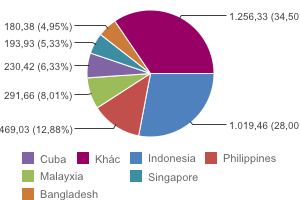Vietnam’s strategy to develop brand-name for exports
(VOVworld) – Although a number of Vietnamese export products rank at the top worldwide, domestic enterprises haven’t made sufficient investment in brand development for their goods. Creating international brands and helping Vietnamese exporters boost export values are key items in the Government’s export development strategy until 2020. VOV’s To Tuan reports…
 |
| Vietnam’s rice exports in 2011 |
Vietnam earned 96 billion USD from exports last year and expects revenues of 110 billion USD this year. In recent years, a number of Vietnamese export items including agricultural and seafood products have ranked first globally. Vietnam currently is the world’s biggest rice exporter with an output of 7 million tons a year. Vietnam’s tra fish exports account for a big share of the world market and last month Vietnam overtook Brazil as the world’s top coffee exporter. Despite achievements in export quantity and quality, many Vietnamese export items have failed to build a recognizable brand. For instance, Vietnamese tra fish is available in 125 countries, but foreign consumers are more aware of the names of the importers than where the product comes from. The problem is that Vietnamese companies pay too little attention to the issue. Most Vietnamese exporters are small to medium-sized enterprises whose financial resources are too limited to invest in brand building. Economist Mai Thi Duyen says that Vietnamese exporters lack information on market and legal frameworks to protect their brands in the context of international integration. Duyen notes ‘
Domestic enterprises should prioritize brand development which is closely linked to many issues. Brand building isn’t just the development of a product image and a company logo. It’s also product quality, production process, and business prestige.’
Brand building is a must as low prices are no longer a sufficient competitive advantage in the market. The more Vietnam integrates into the world, the more Vietnamese brands are forced to compete with better-known trademarks. Do Ha Nam, President of the Vietnam Pepper Association says that it’s because of Vietnamese goods’ low added value. Nam elaborates ‘All exporters do their best to develop a brand-name because a good brand means their products can be sold at a totally different price. We all know that a product made by a factory will cost twice as much if it is branded by an international standard company.’
The Government has outlined a master strategy to develop brand-names for Vietnamese products and create a link among domestic businesses. Nguyen Minh Huong, Director of the A Hoang Law Office which specializes in export brand consultancy, says ‘The Government has programs to support the development and protection of Vietnamese brands, especially by encouraging enterprises to make full use of their intellectual property rights to increase product value. These include the program on national brand building initiated by the Ministry of Industry and Trade, and programs in collaboration with the National Office of Intellectual Property to support the protection of business intellectual property, to encourage domestic exporters, and to protect brands.’
Some Vietnamese export groups have been building their brands professionally. The country’s garments and textile sector is one example. Vietnam used to do processing for exports, the amount of export made-in-Vietnam products has made up 30% of the industry’s total exports and the ratio is planned to increase by 50% in 2014.
To Tuan